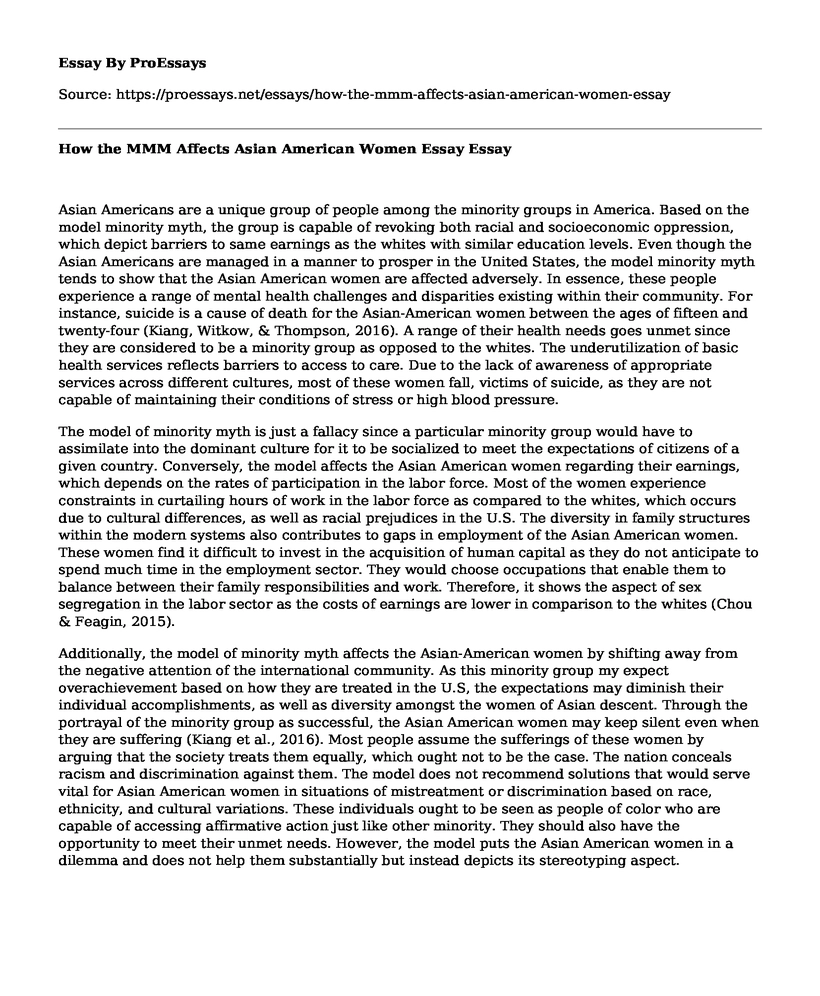Asian Americans are a unique group of people among the minority groups in America. Based on the model minority myth, the group is capable of revoking both racial and socioeconomic oppression, which depict barriers to same earnings as the whites with similar education levels. Even though the Asian Americans are managed in a manner to prosper in the United States, the model minority myth tends to show that the Asian American women are affected adversely. In essence, these people experience a range of mental health challenges and disparities existing within their community. For instance, suicide is a cause of death for the Asian-American women between the ages of fifteen and twenty-four (Kiang, Witkow, & Thompson, 2016). A range of their health needs goes unmet since they are considered to be a minority group as opposed to the whites. The underutilization of basic health services reflects barriers to access to care. Due to the lack of awareness of appropriate services across different cultures, most of these women fall, victims of suicide, as they are not capable of maintaining their conditions of stress or high blood pressure.
The model of minority myth is just a fallacy since a particular minority group would have to assimilate into the dominant culture for it to be socialized to meet the expectations of citizens of a given country. Conversely, the model affects the Asian American women regarding their earnings, which depends on the rates of participation in the labor force. Most of the women experience constraints in curtailing hours of work in the labor force as compared to the whites, which occurs due to cultural differences, as well as racial prejudices in the U.S. The diversity in family structures within the modern systems also contributes to gaps in employment of the Asian American women. These women find it difficult to invest in the acquisition of human capital as they do not anticipate to spend much time in the employment sector. They would choose occupations that enable them to balance between their family responsibilities and work. Therefore, it shows the aspect of sex segregation in the labor sector as the costs of earnings are lower in comparison to the whites (Chou & Feagin, 2015).
Additionally, the model of minority myth affects the Asian-American women by shifting away from the negative attention of the international community. As this minority group my expect overachievement based on how they are treated in the U.S, the expectations may diminish their individual accomplishments, as well as diversity amongst the women of Asian descent. Through the portrayal of the minority group as successful, the Asian American women may keep silent even when they are suffering (Kiang et al., 2016). Most people assume the sufferings of these women by arguing that the society treats them equally, which ought not to be the case. The nation conceals racism and discrimination against them. The model does not recommend solutions that would serve vital for Asian American women in situations of mistreatment or discrimination based on race, ethnicity, and cultural variations. These individuals ought to be seen as people of color who are capable of accessing affirmative action just like other minority. They should also have the opportunity to meet their unmet needs. However, the model puts the Asian American women in a dilemma and does not help them substantially but instead depicts its stereotyping aspect.
References
Chou, R. S., & Feagin, J. R. (2015). Myth of the model minority: Asian Americans facing racism. London: Routledge.
Kiang, L., Witkow, M. R., & Thompson, T. L. (2016). Model minority stereotyping, perceived discrimination, and adjustment among adolescents from Asian American backgrounds. Journal of youth and adolescence, 45(7), 1366-1379.
Cite this page
How the MMM Affects Asian American Women Essay. (2022, Jun 17). Retrieved from https://proessays.net/essays/how-the-mmm-affects-asian-american-women-essay
If you are the original author of this essay and no longer wish to have it published on the ProEssays website, please click below to request its removal:
- Environment I was Raised In - Essay Sample
- Biographical Essay on Lenore Tawney
- Essay Sample on Radical Worldview
- Falsely Accused/Racial Controversy - Research Paper
- Essay Sample on Stuart Hall's Encoding/Decoding Model of Communication
- Exercise Benefits for Youth and Elderly: Training Guide and Physiological Adaptations - Essay Sample
- Captain Marvel: A Marvelous Superhero Movie With Unique Features - Essay Sample







